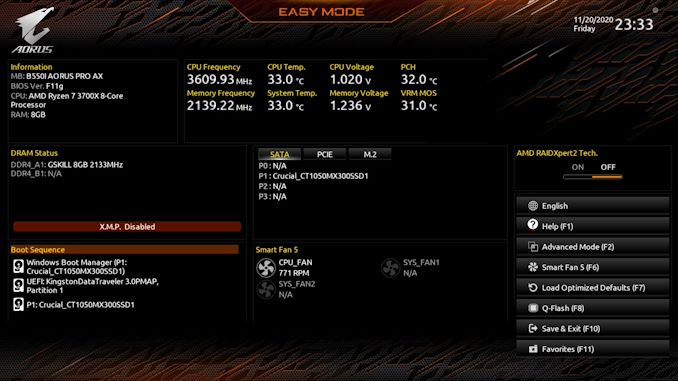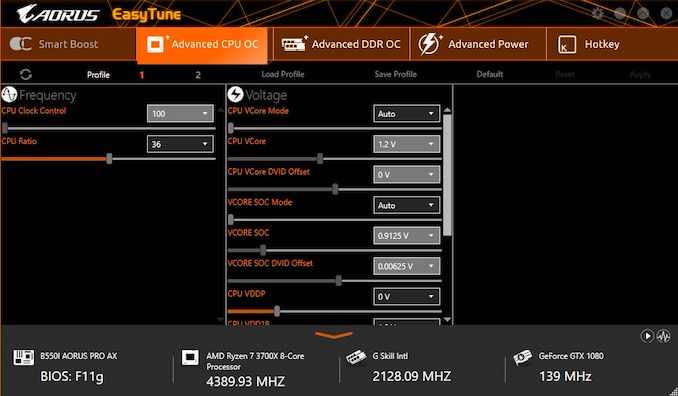The GIGABYTE B550I Aorus Pro AX Motherboard Review: All The Small Things
by Gavin Bonshor on December 7, 2020 10:00 AM ESTBIOS
Unspringsingly, GIGABYTE's B550 firmware is practically identical to its X570 models, as we've seen previously in our GIGABYTE X570 I Aorus Pro WIFI review. The GIGABYTE UEFI firmware for its AMD 500 series Aorus branded models follows a distinct black and orange theme, with white text and orange highlighting. Looking at the BIOS layout, GIGABYTE has split the firmware into two modes, easy mode for the beginner and advanced for the more experienced user.
Focusing on the Easy mode screen, which is the default screen when POSTing for the first time, displays basic yet relevant information about hardware installed. Towards the top is a list of information, including the motherboard model, the BIOS version (F11g for our test), and the processor and amount of memory installed. Users can select between the different types of devices to check if the hardware is installed correctly, including SATA, PCIe, and M.2 devices, as well as a basic list of Smart 5 fan details for the board's three 4-pin fan headers. Along the right-hand side, users can select between different functions, including the advanced mode by pressing the F2 key, load up the Smart Fan 5 tuning utility by pressing F6, and the board's integrated Q-Flash utility for updating the board's firmware by pressing the F8 key.
The rest of the board's firmware focuses on the Advanced mode, which can be done by pressing the F2 key. This allows users to select between various BIOS functions, including the Tweaker sections where all of the board's CPU, memory, and integrated graphics overclocking can be done. Users can adjust CPU frequency, the base clock (BCLK), CPU VCore, among many other voltage settings, including CPU VDDP and DRAM termination voltages. This is also where users can enable XMP profiles at the click of a button or customize memory profiles further for performance tweakers. It should be noted the sweet spot for Ryzen 3000 processors is DDR4-3600, with an Infinity Fabric clock speed of 1800 MHz.
Overall, GIGABYTE's Aorus UEFI firmware keeps things simple with the basic mode, with a basic looking, but the bountiful and endless list of configurable variables, most of which can be found in the Tweaker section. The firmware itself is responsive and offers users from both the novice and advanced spectrums plenty of options to work with.
Software
All of the major motherboard vendors have equally impressive software packages, with various functions to use all of the boards primarily features. GIGABYTE includes plenty with the B550I Aorus Pro AX model, including the EasyTune software designed to allow users to overclock within Windows, the RGB Fusion 2.0 software to control the board's RGB capabilities, and the System Information Viewer (SIV). The SIV software allows users to access the Smart Fan 5 utility within Windows and allows for system alerts for over-voltage and various temperatures.
The most prominent piece of software bundled with the GIGABYTE is the Aorus Easy Tune software. This allows users to overclock the memory and CPU within Windows, with plenty of voltage options and important CPU ratio and memory ratio settings. We still recommend all of the overclocking is done within the BIOS, but overclocking software has come a long way over the last decade, and Easy Tune is quite intuitive.
Unfortunately, GIGABYTE doesn't include any audio software within the bundle, and users looking to make customizations will need to download the Realtek Control Panel directly from the Microsoft Store. Focusing on what is actually there, the bundle offers plenty of customizability. This includes the Fusion 2.0 RGB software for those adding additional RGB LED strips and the Realtek Gaming LAN manager for traffic shaping when used with the RTL8125 2.5 GbE port on the rear panel. It's not the most comprehensive software suite we've seen over the years, but it's more than enough for a sub $200 model aiming at the mid-range.
























76 Comments
View All Comments
mkarwin - Tuesday, December 15, 2020 - link
It might have inferior codec setup, but allows better flexibility and connectability using the rear panel I/O audio ports...Questor - Wednesday, December 9, 2020 - link
Unfortunately for Gigabyte, the lack of a front USB-C header is a deal breaker. I had the same thought you did, hoping and holding out for a V2.Gigaplex - Wednesday, December 9, 2020 - link
How much of a dealbreaker? You can get USB3 to USB-C header adapters.Questor - Thursday, December 10, 2020 - link
Hm. I didn't think about that. Amazing how we miss things right in front of us. Not so much of a deal breaker me thinks. As long as the USB connection is reachable, since it wasn't placed as a front panel header.OliveGray - Sunday, December 13, 2020 - link
These are 2 pay checks $78367 and $87367. that i received in last 2 months. I am very happy that i can make thousands in my part time and now i am enjoying my life. Everybody can do this and earn lots of dollars from home in very short time period. Just visit this website now. Your Success is one step away Copy and Paste___bit.ly/googlework43kkilobyte - Monday, December 7, 2020 - link
Hopefully, it isn't as buggy as their X570 motherboards, that drop dead randomly and require removing the CMOS battery to be able to start it again - an issue that Gigabyte, in more than a year, never solved or even tried to solve.meacupla - Monday, December 7, 2020 - link
That seems to be a common issue on any Gigabyte motherboard.It's like their EEPROM chips have a 50% failure rate within 3yrs and 90% in 5yrs
Deicidium369 - Monday, December 7, 2020 - link
I have dozens in service - some going back to Conroe and never once have had a EEPROM die - maybe you should look at your power delivery system.Samus - Monday, December 7, 2020 - link
I’ve seen EEPROM failure on a few gigabyte boards going back to socket 939 it’s widely known to be an issue and Gigabyte seemingly knows it because they were making the first (only behind ABIT and DFI) to advocate ‘DualBIOS’ which they naturally did away with awhile back because it is expensive.star-affinity - Tuesday, December 8, 2020 - link
:-OIs that why my (or my sister's nowadays) 11 year old Gigabyte GA-EX58-UD5 behaves like this:
https://www.dropbox.com/s/f0bgoxfquiu7mky/GA-EX58-...
I've done all I know of, switching around RAM modules, remove the CMOS battery, press reset CMOS on the back. Got it to start BIOS recovery from the ”DualBIOS” once, but even during that process it turned itself off.
Could be the power supply perhaps, but I've seen other videos online of Gigabyte motherboards doing the same.